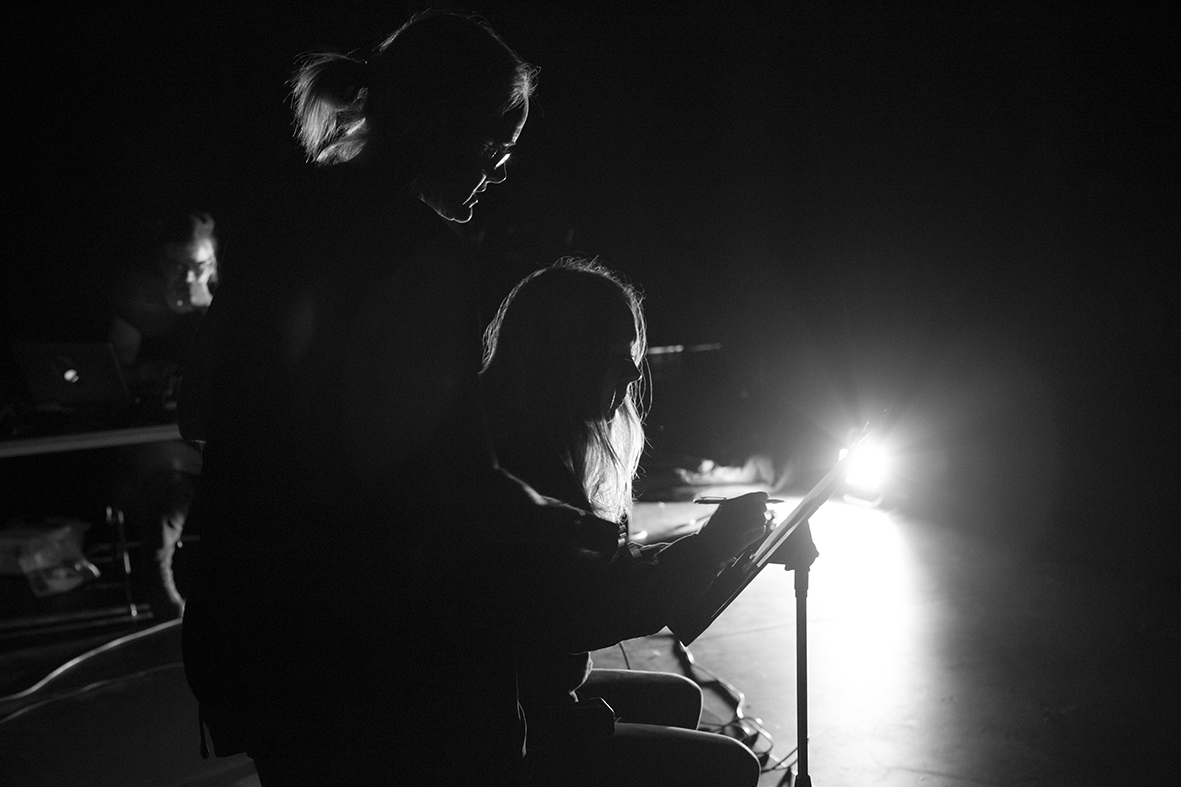I don’t think I was prepared for this performance. I’m not an edgy person; I don’t seek out situations that purposely evoke negative emotions, and I don’t listen to angry music.
Trigger Warning is a concoction of noise concert, rock performance, improvised monologue and dramatic lighting; all designed to explore the reality of women who have suffered and survived the horrors of war. As you would expect, it was a hard drink for me to swallow.
It became apparent that I was out of my comfort zone the moment I entered the theatre at the Perth Institute of Contemporary Arts. Everyone was in black, everyone was drinking red wine, and everyone was cooler than me. But as the lights dimmed, something fascinating happened. Out of the settling darkness strode a woman, no taller than me, with a warm face and bright red hair. I’m pretty sure her shirt was floral. She took a deep breath in and began to tell me a story. It wasn’t pleasant, and it wasn’t her story, but by the time she had finished that introduction she had me in the palm of her hand. My emotions were putty-ready to be moulded into whatever extreme she chose.
We began to explore the world that had been masterfully constructed on stage by performer Hayley McElhinney (The Babadook, Sydney Theatre Company’s War of Roses), Lighting Designer Joe Lui and composer Dr. Cat Hope. It wasn’t a beautiful world. At times the lights that were lined across the back wall would flash like strobes to the shouts of McElhinney, the screams of the guitar and the throbbing rhythm of a drum. At least twice she fell to the floor, her body convulsing under those violent lights as if possessed or fitting.
At other times, the music would slow and all lights would turn off save for a single bare bulb hanging from an exposed wire. McElhinney would reach up and swing the disembodied bulb, casting a nauseating, perpetual sway of light across the room. She would whisper to us, in an accent I could no longer place, of how her husband’s body had looked when it was blown apart; how she had held her bleeding son as he died; how she wished she too could have died. In these moments I felt my heart rate rising. The quieter her voice became, the closer the microphone moved towards her mouth and I found myself filled with the bizarre fear that I was going to be consumed.
 Filled with confronting scenes, McElhinney hit the floor with a hammer and even adopted a creepy British accent and the personality of a psychotic little girl. Though it appeared to be lighthearted, the most confronting occurred about two thirds of the way through, when she got up to end the performance. Everyone clapped and she seemed to come out of character. The Australian accent returned and her body relaxed in the way a dancer does after the music has ended. The lights had even begun to come back up. She then directed a comment to someone at the back, “Where do you think you’re going?”. It was so convincing I turned around to spot the victim, but no-one had stood up. She then started a blunt and horrifically intimate description of a rape. Except it was performed in a style that so perfectly mimicked comedy that at times I had to fight the urge to laugh. Flooded under a single spotlight, with the utmost sincerity, she told us a story of horrific violation in a tone that left me waiting for the punchline all night. It was horrible. I don’t think I’ve ever felt so much discomfort, so much revulsion in my life. And I think that’s exactly what director Sally Richardson wanted. I wasn’t meant to leave that theatre feeling warm or safe.
Filled with confronting scenes, McElhinney hit the floor with a hammer and even adopted a creepy British accent and the personality of a psychotic little girl. Though it appeared to be lighthearted, the most confronting occurred about two thirds of the way through, when she got up to end the performance. Everyone clapped and she seemed to come out of character. The Australian accent returned and her body relaxed in the way a dancer does after the music has ended. The lights had even begun to come back up. She then directed a comment to someone at the back, “Where do you think you’re going?”. It was so convincing I turned around to spot the victim, but no-one had stood up. She then started a blunt and horrifically intimate description of a rape. Except it was performed in a style that so perfectly mimicked comedy that at times I had to fight the urge to laugh. Flooded under a single spotlight, with the utmost sincerity, she told us a story of horrific violation in a tone that left me waiting for the punchline all night. It was horrible. I don’t think I’ve ever felt so much discomfort, so much revulsion in my life. And I think that’s exactly what director Sally Richardson wanted. I wasn’t meant to leave that theatre feeling warm or safe.
From the moment McElhinney walked onto that stage, she had me. I liked her. I liked her top and I liked her boots. I liked her because she looked like someone who I would want to be friends with. Someone who I could listen to happy music with. Instead she pulled me into a world that terrified me and she did it so convincingly that I forgot about her floral top and her warm face. I left that theatre drained and overwhelmed, and that’s exactly what they wanted.
Words by Caitlin Carr
Trigger Warning ran for two nights at the PICA Performance Space. Read interview with writer/director Sally Richardson here.

